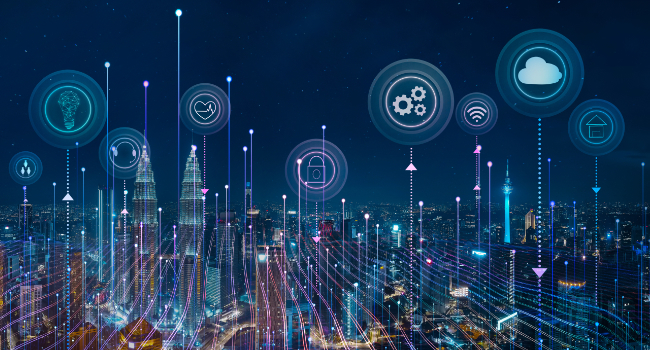
Impact on Digital Transformation
- By Charles Pitman
- Sep 11, 2024
A 2023 Statista report projects that by 2030 there will be 30 billion Internet of Things (IoT) devices in use. That is three times as many as there were in 2020. The numbers continue to grow because connecting sensors and systems, especially across a business, promises big efficiency gains and new insights. As such, the IoT and IIoT (Industrial Internet of Things) have become a launching pad for digital transformation -- not only for individual organizations but for entire industries.
There are implications for physical security, however, as connecting more devices to IT networks makes both more vulnerable to cyberattacks. Here are best practices on how to bring all your organization’s IoT/IIoT data together to generate meaningful outcomes while mitigating cybersecurity risks.
Terms Clarified: IoT and IIoT
The IoT is a networked ecosystem of devices that connect and exchange data with each other over the Internet or other networks. While IoT generally relates to consumer-connected devices, IIoT is focused on device connectivity across a business to facilitate monitoring and support operations.
Today, many organizations are implementing IIoT strategies to achieve specific business outcomes. Some are merging VMS and access control systems with lighting and HVAC solutions to enhance automation, reduce energy consumption and meet sustainability mandates.
The Role of the Cloud in IIoT Evolution
The cloud continues to broaden opportunities for businesses that want greater connectivity across their IIoT devices. It provides the flexibility to deploy new solutions while bringing existing investments into the IIoT environment. For example, new cloud-connected infrastructure appliances are streamlining the transition to a hybrid-cloud architecture.
Whereas existing investments may have held organizations back from launching new IIoT strategies, these plug-and-play cloud appliances are bridging the gap and helping them modernize their installations. Cloud solutions are making it simpler, more affordable, and even more secure to bring systems and data together and make it accessible from any location.
One of the biggest concerns for organizations is IIoT cybersecurity because the risk of cyberattacks and data breaches grows along with the number of connected devices. Though the cloud is a main catalyst in IIoT, the long-held belief that the cloud is not secure is not true. With the right cloud solution, organizations can access cloud-enabled tools to keep IIoT device firmware up to date and benefit from many built-in cybersecurity features that help automate processes and stay on top of threats.
Unification and Analytics, Make Sense of IIoT Data
Connecting hundreds or thousands of sensors can benefit organizations only if they have the tools to make sense of the incoming data. With an open, unified platform, you can bring data from various sensors and systems into one solution. This creates a solid foundation on which you can keep expanding your IIoT initiatives.
For instance, you might start by combining your VMS, ACS, and intrusion systems into one platform. Doing this will give security staff a clearer picture of events and enable them to quickly respond to threats and incidents. From there, you might bring in other business systems such as intercom, building management, point-of-sale, or automatic license plate recognition (ALPR). Having all these sensors drive data into a single platform gives your team a better understanding of what is happening across your business.
Real-world Use Cases
Automating HVAC airflow in airports based on crowd levels. Ensuring proper airflow throughout the airport is critical, but running HVAC systems at full throttle all the time is not cost or energy efficient. At an airport in Canada, the operations team leverages video surveillance and crowd estimation analytics to better control airflow. If their unified security platform detects a crowd forming in a specific area, the system triggers the HVAC airflow in that zone to increase. When the crowd subsides, so does the airflow.
Detecting illegal dumping across a city. Cities often have trouble managing illegal dumping activities. The City of New Orleans (NOLA) took an innovative approach to the problem. NOLA’s Sanitation Department and Real Time Crime Center worked in partnership to install cameras at known dumping sites. The team also set up an event-to-action rule in their unified security platform. Motion is detected in a defined zone of the camera’s field of view, it captures the footage and emails it to specific people. Within two days of setting this event-to-action up, NOLA was able to identify and arrest a repeat offender.
Identifying temperatures in server rooms. Data center server rooms often house critical systems and data. Keeping them cool ensures investments are protected and business runs as usual. One way to track temperatures for these applications is by installing air temperature sensors in identified rooms. If a cooling system fails and temperatures rise or reach a threshold, teams are alerted. They can then investigate and remediate.
Bringing IIoT Sensor Data Together
Organizations are actively exploring ways to leverage the data from the many IIoT devices in their environment. But with cybersecurity top of mind and endless possibilities on offer, it is not always easy to find the best path forward. Working with a trusted vendor is critical. They can help you assess your current environment, build a phased roadmap, and guide you through the process of achieving your IoT/IIoT objectives.
This article originally appeared in the September / October 2024 issue of Security Today.